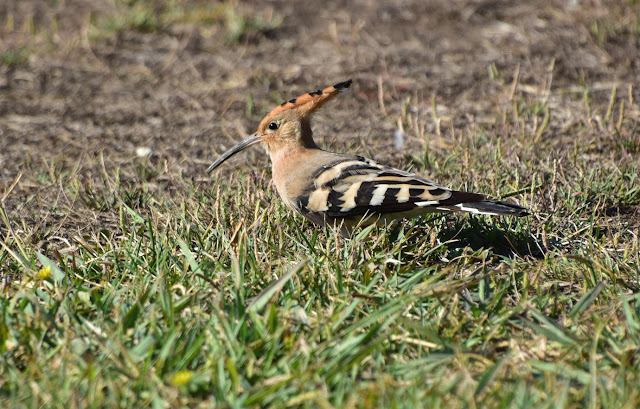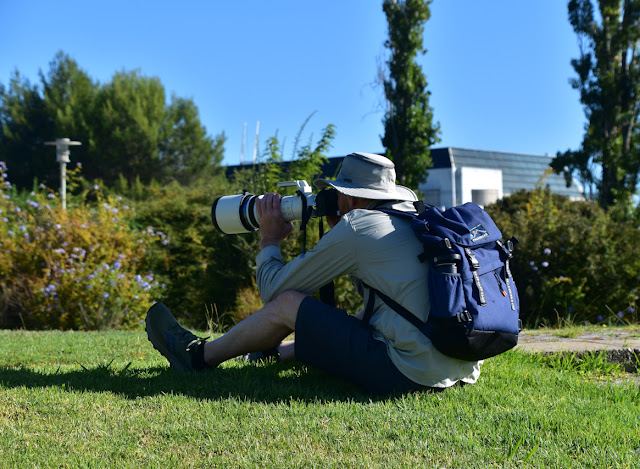The Safari has met up with RL, our Extreme Photographer, in Poland, almost did so in Perth, Australia, and now he was waiting for us at the dock gates in Porto, Portugal - well Leixoes actually as the city of Porto isn't quite on the coast but a little way up the Douro river. Close enough for the 'P's we guess - where next, Papua? Paraguay? Palau would be good!
WE nearly didn't make it to the dock gate and almost certainly wouldn't have done had we had our scope with us as there were thousands of gulls of all shapes and sizes to scan through. Tempting as they were we didn't stop for more than the briefest of perusals. Beside the dock gate there was a tiny garden with a shrine in it. RL had already seen a good variety of birds while waiting for us to walk up from the ship. He soon put us onto Spotless Starlings, unphotographable again, a couple of White Wagtails, Serins, several Pied Flycatchers, Black Redstart, a Spotted Flycatcher and a Chiffchaff...a busy little corner or greenery and suggestive of a bit of an overnight fall before the morning mist descended. RL had found a park close by worthy of exploration, he'd already seen a Night Heron in there when walking throughdown to the docks to meet us, so off we went along the beach. The mist was pretty thick so we didn't stop to look at the big gull roost on the sands. Making our way to another old fort sat out on another rocky promontory we found an out of context Pied Flycatcher and yet more busy Black Redstarts, do they ever sit still? The outer rocks by the surf held a small number of Turnstones.
Skimming around the lake were several Swallows, a species we'd so far seen very few of. Deeper into the park we'd discover that Pied Flycatchers were probably the most numerous bird with Spotted Flycatchers someway behind in second place.
On a small patch of dry lawn something small and white caught our eye, not a tiny scrap of paper but a Vestal moth. This species is resident here but a usually scarce migrant to southern Britain but can occasionally occur in large numbers.
So far this trip we hadn't seen any lizards, mainly due to the nightmare cat situaution in the previous places. RL is a lizard finder extraordinaire and it was his mission to show us some. Apparently he'd seen very few since travelling around Portugal since the spring. A likely looking wall in the distance was aimed for but on the way we got side tracked by a the number of Jays flying to and fro collecting acorns. They came out of the trees without warning and soon disappeared behind intervening foliage so getting a pic was nigh on impossible until one landed low down on a tree not too far away but annoyingly in deep shade.
The sun had now mostly burnt off the mist but cool sea frets still wafted their chilly dampness across the park from time to time making everything very atmospheric, not the best conditions for finding lizards. A sunny wall was scanned from a distance, RL had said that the few lizards he had seen so far were all very skittish and unapproachable. And just like that he found one, a small juvenile having a good play at being Spiderman.And then just a yard or so beyond that one he found another in the grass at the base of the wall - how'd he spotted that???Walking quietly along the wall but well away from it gave us more sightings, trying to creep closer for a definitive view was very difficult, any hint of movement and they bolted into their favourite hidey-hole. Occasionally one would get caught out too far from the safety of a crack in the blockwork and would freeze for a few moments before deciding to make a dash for it.
Eventually, after numerous failures, we did get a reasonably close up pic.
There are several similar species found in this area and we may have got pics of more than one of them but they are all very variable and very hard to tell apart.
After a brew and butties back his van we carried on our search for more reptiles. It was warmer now the mist was completely gone and butterflies were on the wing, and mostly not for settling. There were many blues, many very tatty coming towards the end of their season and most not able to be identified as we couldn't get a good look at their underwings. With persistence did find most to be Lang's Short Tailed Blue and Geranium Bronze. No idea what this very tatty one is though.Most of the other butterflies were Large and Small Whites and we had at least one Red Admiral and several Speckled Woods.
Around a smaller pond we came across another reptile, a fallen long reaching into the water just screamed 'terrapins' and sure enough a quick check with the bins gave us an Iberian Pond Turtle exactly where we would have expected one to be.
A much larger lake was visited next and here we saw another non-native horror, many huge Koi Carp.
No wonder there were few dragonflies on the other pools any living thing will have long been sucked up by these monsters. And they were breeding, warm shallow areas had tens of thousands of fry, far too many for that Kingfisher we saw earlier to make a dent in their numbers. One stretch of the margins of this pond had a reasonable fringe of emergent vegetation and on our drier side a lot of Spearmint plants, giving off a lovely scent as you we walked over it. Marsh Frogs jumped out of way as we walked along the banks trying to find a Grass Snake (any snake would do) sunning itself. The last time we saw these we were in Poland with RL all those years ago. At last we came across one that didn't jump out of our way.A sunny shorter patch of grass had another species of blue butterfly. Another very fluttery one that we kept getting brief views of the underside of but it wouldn't stay still enough with its wings up for a pic. We got an upperwing pic but then all blues look very much the same from above. Checking in the field guide we'd brought with us back on the ship later it transpired to be a female Mazarine Blue. Another pond/lake gave us more turtles, this time though they were almost all introduced American species, namely Red Eared Slider/Terrapin and Eastern Painted Turtle (in some books Eastern Swamp Slider). There were a couple of native turtles in the mix too but now we know there are two possible species we're not sure which we've seen, they are quite similar, Iberian Pond Turtle and Stripe Necked Turtle.Walking back by the big lizard wall we had another look but now the sun was off it and the lizards already warmed up there were none to be found. The day was warm now and the bird action had died down too, hardly any Pied Flycatchers were to be seen. Time to head back to the ship and say our goodbyes and thanks for a marvelous lizard spotting day to RL. Going through the last much more open bit of the park there was a low wall, more a row of blocks of stone hawkeyed RL spotted the last lizard of the day basking on the top of one of them.
We left RL at the dock gates and walked back to the ship but seeing far fewer gulls on the quayside, he went back to his van in the park to drive up the coast towards the Spanish border to find a campsite for the night before his next leg of his Iberian adventure into the hills and mountains of Galicia. It had been great to catch up.
Once again the evening log call wasn't a protracted affair.We reached as far north as Bardsey Island and the Lleyn Peninsula as it went dark, in the morning we'd awake back in Liverpool.
All that remains to be said is a huge thank you to the other members of the OWE team, the guests who chatted with us through thick n thin and especially those who kindly allowed us to use their images. We can't forget Fred Olsen cruise's crew and staff who always look after us so well. But mostly to IH who put us forward for the trip after he'd had to withdraw for unfortunate family reasons.
Oh and that one species short of our Challenge target??? There were two Black Terns a minor detour away on the way back to Base Camp but we were too knackered to take advantage of them. Thankfully they were still there in the morning so we picked up CR and headed out.165 species of birds photographed within 75 miles of Base Camp - Target reached we can relax for the next three months...oh no we can't we've upped the target to 170.
In the meantime let us know who's racing up undetected in your outback.
































































































